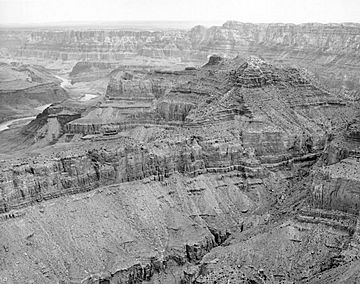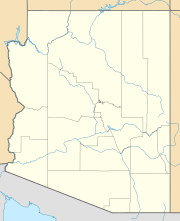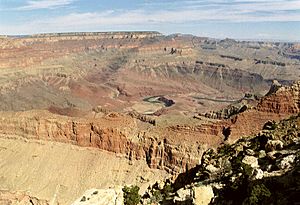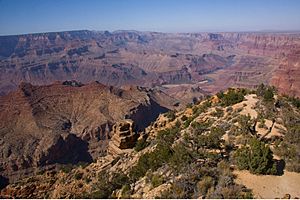Escalante Butte facts for kids
Quick facts for kids Escalante Butte |
|
|---|---|

southwest aspect
(shows long platform northwestwards of top of Redwall Limestone) |
|
| Highest point | |
| Elevation | 6,536 ft (1,992 m) |
| Prominence | 876 ft (267 m) |
| Parent peak | Navajo Point (South Rim) |
| Geography | |
| Location | Grand Canyon Coconino County, Arizona. U.S. |
| Topo map | USGS Desert View |
| Geology | |
| Age of rock | Permian down to Cambrian |
| Mountain type | sedimentary rock: sandstone, shale, siltstone, mudstone, sandstone, shale |
| Type of rock | Coconino Sandstone-(prominence), Hermit Shale, Supai Group-(eroded ridgeline), Redwall Limestone, Muav Limestone, Bright Angel Shale |
Escalante Butte is a tall rock formation, or butte, located in the eastern part of the Grand Canyon in Northern Arizona. It stands about 6,536 feet (1,992 meters) high. Just to its east is a slightly smaller butte called Cardenas Butte. Both of these buttes, along with the Grand Canyon's South Rim, are part of the land that drains into Tanner Canyon, which then flows into the Colorado River.
What is Escalante Butte?
Escalante Butte is a prominent landform in the Grand Canyon. A butte is a type of hill with steep sides and a flat top. It's like a smaller version of a mesa. Escalante Butte is named after Francisco Garcés, a Spanish explorer. It's a great example of how the powerful forces of nature, like wind and water, have shaped the landscape of the Grand Canyon over millions of years.
Geology of Escalante and Cardenas Buttes
Escalante Butte and Cardenas Butte are both made of similar types of rock and sit on the same long ridge. This ridge is mostly formed from a group of rock layers called the Supai Group.
Escalante Butte is separated from Cardenas Butte by a lower area, or saddle, where water drains into Tanner Canyon. The very top part of Escalante Butte is made of Coconino Sandstone. This sandstone sits on top of softer rock layers like the Hermit Formation (also known as Hermit Shale). Below these are the older, eroded ridges of the Supai Group.
Cardenas Butte is about 300 feet (91 meters) shorter than Escalante Butte and is located about 0.8 miles (1.3 kilometers) to the east. Its small, pointy top is also a tough rock layer from the Supai Group that has resisted erosion. These buttes show us how different rock layers wear away at different speeds, creating the amazing shapes we see in the Grand Canyon.




